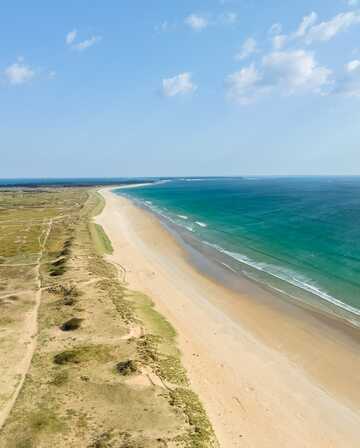A return to nature in the Bay of Quiberon
In the Bay of Quiberon, you have the chance to discover exceptional natural sites! Here, nature is in turn wild, grandiose, welcoming, preserved, relaxing, breathtaking...
The Bay of Quiberon boasts varied and surprising landscapes, such as the Grand site of the wild dunes from Gâvres to Quiberon, the Gulf of Morbihan dotted with islands, and the forêts domaniale de Camors. Treat yourself to a return to nature during your stay in South Brittany.
Experience nature in the heart of the Great Dune Site
On the west side, the Great Site of the wild dunes of Gâvres to Quiberon is located in the heart of a natural site that stretches over 35 km of non-urbanised coastline, and in one single stretch. Listed on a European scale as a Natura 2000 site, it is home to exceptional biodiversity, with many bird species protected at European level and a rare and fragile flora with a unique diversity.
Good to know: in January 2019, the wild dunes were awarded the national label Grand Site de France, which recognises the exemplary and protective management of an emblematic site in our country.
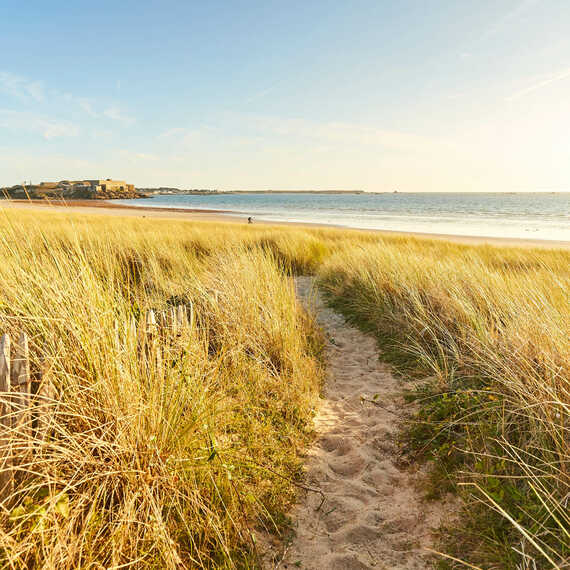
Walk or cycle, to take in the different landscapes. Start out, for example, from Plouharnel along its fields, then its pine woods. The sea will gradually get closer as you advance, and the landscape will open up. You will see the grey dune, which takes its name from the colour of the plants that grow there. It is unique in that it has a surprising lunar appearance, cropped vegetation and a light scent.
We then end up with the mobile dune, more beige in colour, which moves with the winds and tides. Then it's the beach, and what a beach it is! This immense mass of dunes strikes by its beauty and its extent. You enter miles of dunes, a preserved landscape with a curved shape and a clear view of the horizon.
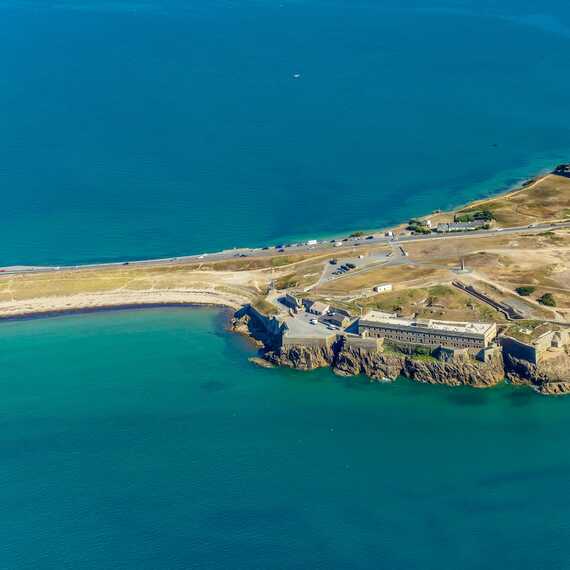
On the south side, we can see a 7 km tombolo, a necessary passage to the Quiberon Peninsula. At its narrowest point (only about twenty metres), the Penthièvre isthmus is bordered by water on both sides, forming a landscape unique in France. On the peninsula, admire the sumptuous Wild Coast, granite cut by the ocean's backwash, but also a landscape of moors where gorse and heather blossom.
On the west side, in the distance, discover the ria d'Étel, a landscape of salt meadows intimately linked to the tide. At its mouth, admire the famous bar, a sandbank against which the sea meets in powerful eddies that often make navigation dangerous. Not far off, on the Erdeven side, the wetlands and the Varquez pond shelter butterflies and dragonflies, in an amazing wooded landscape with alignments of megaliths.
For more information: www.gavres-quiberon.fr
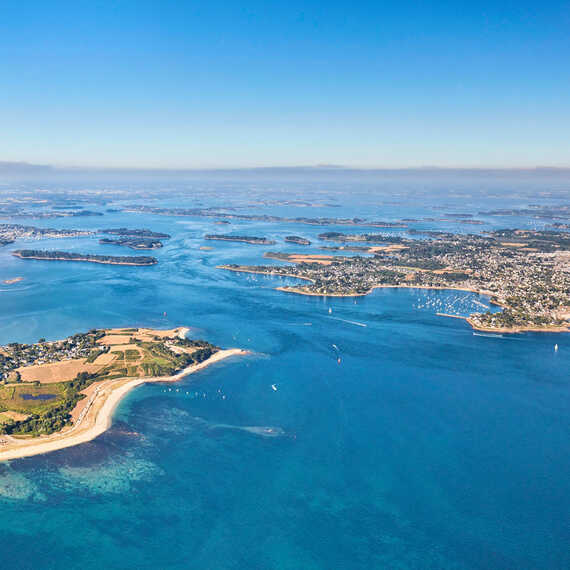
The Gulf of Morbihan dotted with islands
On the east side, you will find an exceptional landscape combining coastline, inland sea, islands and valleys. The Regional Natural Park of the Gulf of Morbihan was created in 2014 to preserve and enhance the site's heritage. Megaliths, classified sites, rare birds and fragile flora populate the Park, the 50th Natural Regional Park of France. On 64,000 hectares of land and 17,000 hectares of sea surface, it gathers varied and exceptional landscapes and resources.
Locmariaquer is the gateway to the Gulf of Morbihan, a small inland sea scattered with as many islands as there are days of the year as the legend goes (42 in reality!).Only a narrow gully, one kilometre wide, between Locmariaquer and Arzon, separates the Gulf from the ocean. This unique place is called Mor Braz in Breton. Walk along the Gulf of Morbihan or visit this wild remarkable site by boat, starting out from Locmariaquer.
Good to know: 3 shipping companies organise guided cruises that provide you with an insight into the history and life of the Gulf.
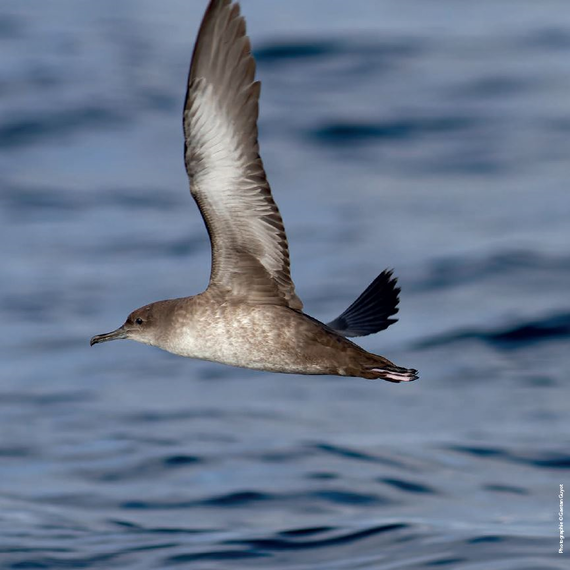
Houat-Hoedic, refuges pour les oiseaux marins
L’archipel de Houat-Hoedic est constellé d’îlots rocheux propices à la reproduction de nombreuses espèces protégées et menacées d’oiseaux marins. De l’emblématique goéland argenté au mystérieux océanite tempête, ces espèces font partie intégrante du patrimoine naturel de notre territoire. Bretagne Vivante, association de protection de la nature, sensibilise la population, les plaisanciers et les visiteurs à la préservation de la tranquillité des oiseaux marins de l’archipel.
De mars à fin août, les îles de Houat et d’Hoedic et les îlots rocheux de l’archipel hébergent huit espèces d’oiseaux marins nicheurs : le goéland marin, le goéland argenté, le goéland brun, l’océanite tempête, le cormoran huppé, l’huîtrier-pie, le gravelot à collier interrompu et le puffin des Anglais (espèce menacée en voie d'extinction). En plus de ces oiseaux nicheurs, de nombreux oiseaux migrateurs font halte dans l'archipel, comme le puffin des Baléares. De passage en été, c'est l'espèce d'oiseau marin la plus menacée d'Europe !
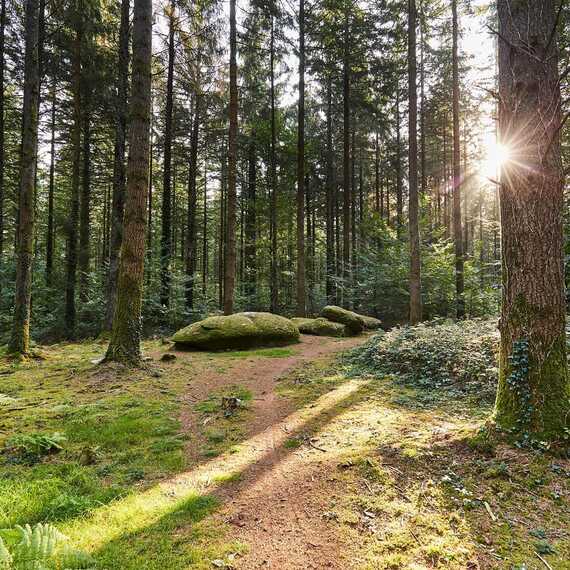
The national forests of Camors
On the northern side, the national forests of Camors, Floranges and Lanvaux cover 1372 hectares and extend over the Camors and Pluvigner municipalities.
So, whether you prefer the marine world, the woods or dunes, the natural heritage gives everyone the opportunity to discover a wide range of original landscapes in the Bay of Quiberon... You are guaranteed to find what you want in the heart of nature!
So, whether you prefer the marine world, the woods or dunes, the natural heritage gives everyone the opportunity to discover a wide range of original landscapes in the Bay of Quiberon... You are guaranteed to find what you want in the heart of nature!

